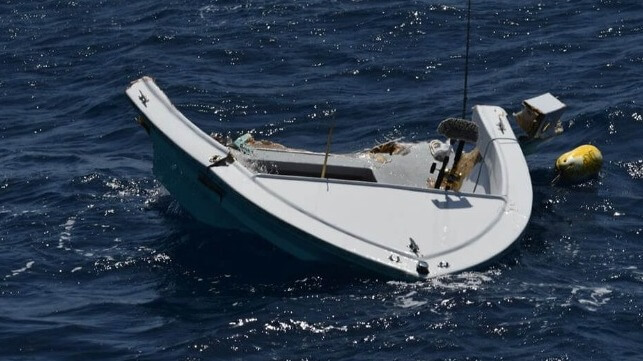Report: Poor Situational Awareness Led to Fatal USCG Cutter Collision

The NTSB has released its final report on the collision between the Coast Guard cutter Winslow Griesser and a small pleasure boat off the coast of Dorado, Puerto Rico this year. The investigators found that both vessels had kept an inadequate watch and that the Griesser had had a hard time picking up the small craft on radar, which could have been fixed if the smaller vessel had installed a radar reflector.
On the afternoon of August 8, 2022, USCGC Winslow Griesser was transiting westbound along the coast of Puerto Rico, about four miles offshore. She was on a routine voyage to Punta Cana, Dominican Republic, where the crew were scheduled to pick up two DR naval officers for a patrol in the Mona Passage. The navigation team assessed the voyage's risk profile as "low," and the watch was augmented with multiple people. At various times, the bridge team included the commanding officer, officer of the deck, conning officer, quartermaster, training petty officer and - as observers - a port engineer and a navigation evaluator. It was the first patrol for about half of her crew.
The Griesser cleared San Juan's harbor entrance at about 1350 hours and increased speed to 29 knots. She turned off her AIS, reflecting her law enforcement mission, and headed out on a westerly course towards the Dominican Republic.
The center-console fishing boat Desakata had gotten under way from Cerro Gordo earlier that morning with the owner and his brother aboard. The boat headed for a fish aggregating device (FAD) buoy about seven miles offshore. It was moving ahead slowly at about five knots, making headway against modest waves.
As Winslow Griesser proceeded westward at twice the speed of a merchant vessel, the officer of the deck was providing the port engineer with a familiarization of the cutter's equipment. The quartermaster was attending to administrative tasks at the back of the bridge. The commanding officer - who declined to be interviewed by NTSB - was on the bridge and working on routes on the port forward console at one point during the transit, according to the port engineer and training petty officer.
At 1416:53, the mast camera on the Griesser picked up the faint outline of the Desakata. 19 seconds later, the cutter hit the center console boat at full speed. Crew on the mess deck heard a loud bang and were startled, but the bridge crew were not aware that they had hit anything. Luckily, a crewmember who was taking a break spotted the debris of the fishing vessel passing down the side and alerted the bridge.
The commanding officer took over the conn, and the patrol vessel quickly turned back towards the scene of the accident. There were two people in the water, and one was waving; neither had life-jackets on. The owner of the Desakata was holding the body of his brother, who had been killed by the impact. A small-boat crew from Griesser recovered both, and the cutter immediately returned to San Juan to bring the owner to higher medical care. He was treated for bruises and a spinal fracture and released the next day.
The owner later told NTSB that neither he nor his brother ever heard or saw the cutter coming, though weather was clear and visibilty was good. An airline passenger happened to watch the whole collision from above, and he told NTSB that both vessels maintained a constant course in the moments leading up to the accident as though they "didn't know it."
The fiberglass-hulled Desakata was cut in half, and its bow would later wash ashore. Griesser suffered cosmetic damage to its hull paint.
The commanding officer of Griesser was relieved of duty, and the Coast Guard has launched its own investigation into the cause of the casualty.
NTSB concluded that neither vessel had spotted the other and that both were keeping an inadequate lookout. In prevailing conditions, Desakata could have spotted Griesser as early as five minutes before the casualty, even at the cutter's high rate of speed. Griesser should have been able to see Desakata about nine minutes out. However, even with five people on the bridge, the CO and the officer of the deck did not ensure adequate situational awareness for a speed of 29 knots, NTSB concluded. The investigators listed this as a contributing factor in the casualty.
"The Coast Guard’s entire cutter fleet may also encounter conditions under which its bridge watchstanders are prone to multi-tasking or distraction. Lessons learned from tragedies like this one can be useful as training tools and for reviewing current watchstanding (in particular lookout) practices," advised NTSB.
The agency noted challenges in its inquiry. The commanding officer, officer of the deck and quartermaster of the watch all turned down NTSB's interview requests on the advice of their lawyers, so the investigators had to reconstruct the scene from the testimony of other people. Two days of pages from the OOD's records of work and rest were missing. Further, the cutter did not have an installed VDR, so there was no record of the radar picture or the conversations on the bridge. (Government vessels are not required to install a VDR.) NTSB has long advocated for broader application of VDR requirements, and said that it will need to have IMO-equivalent VDR data capture if it is to properly investigate future Coast Guard casualties.
